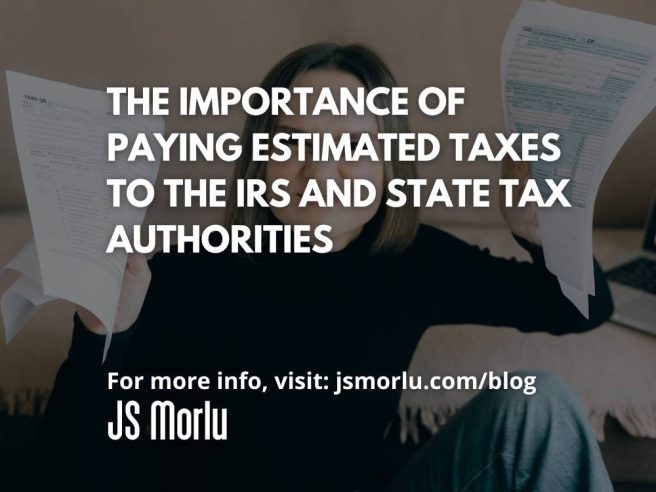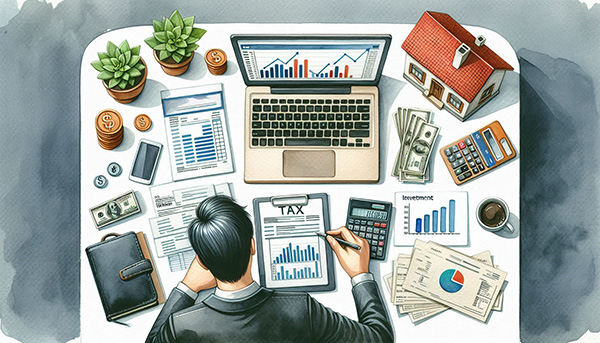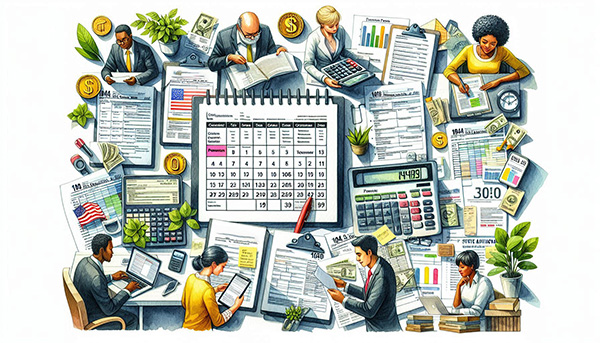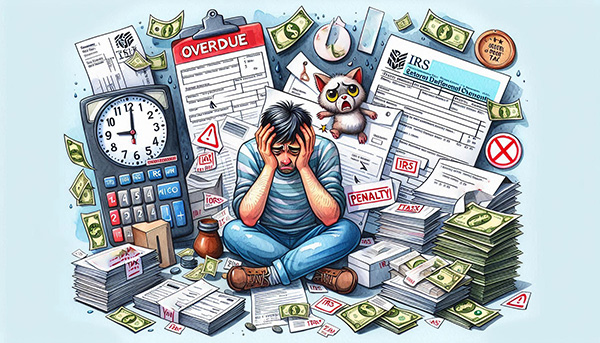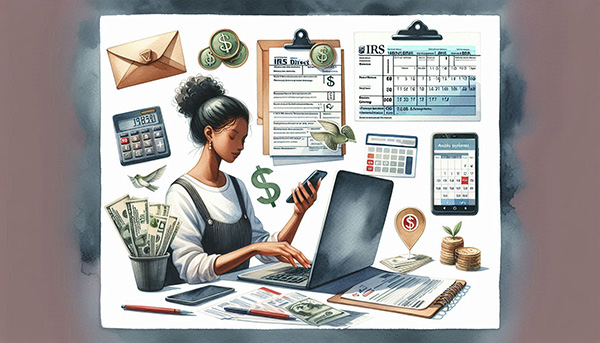By: John S. Morlu II, CPA
When most Americans think of taxes, they think of April 15, the standard tax filing deadline for income taxes. However, for freelancers, self-employed individuals (1099 contractors), small business owners, retirees with significant income from sources like investments, and others whose tax payments aren’t automatically deducted from their income, the need to pay estimated taxes throughout the year is essential. Estimated taxes ensure that taxpayers are meeting their tax obligations on time and avoid the significant penalties that come with late payments.
In this article, we’ll delve into what estimated taxes are, why they’re important, who needs to pay them, and the penalties for failing to meet these obligations. We’ll also review the rules surrounding estimated tax payments and how you can manage this process effectively.
What Are Estimated Taxes?
Estimated taxes are payments made periodically throughout the year to both the IRS and state tax authorities by individuals or businesses whose income isn’t subject to withholding. For most salaried workers, income taxes are automatically withheld from their paycheck by their employer and sent to the IRS and state tax agencies on their behalf. But if you are self-employed, a freelancer, a high-income retiree earning from capital gains, or a small business owner, you may have to estimate your income for the year and pay a portion of taxes on that income quarterly.
Estimated taxes typically apply to income earned through self-employment, investments (dividends, interest, or capital gains), rental income, and even retirement income if insufficient tax is withheld.
Why Are Estimated Taxes Important?
1. Avoiding Penalties: The IRS expects taxes to be paid as income is earned. If you fail to pay enough tax throughout the year, you may face a penalty when you file your tax return. This penalty applies even if you file your return and pay the balance on time, making estimated tax payments crucial for avoiding unnecessary costs.
2. Smooth Cash Flow: Paying estimated taxes quarterly spreads out your tax liability over the year, reducing the burden of a large tax bill in April. Small businesses, in particular, can benefit from managing their cash flow by aligning tax payments with their income cycle.
3. Compliance with the Law: Estimated taxes aren’t optional. Failure to make appropriate payments can lead to substantial penalties. Even retirees who think that tax season is behind them can find themselves in trouble if their income from investments or pensions isn’t adequately taxed throughout the year.
Who Needs to Pay Estimated Taxes?
Certain individuals and businesses must make estimated tax payments due to income that isn’t subject to automatic withholding. This responsibility applies to a diverse group, including freelancers, retirees with significant investment income, and business owners, among others. Here’s a breakdown of the key groups that typically need to pay estimated taxes:
1. Self-Employed and Freelancers (1099 Workers): Self-employed individuals and freelancers—commonly categorized as 1099 workers—earn income that is not subject to automatic tax withholding, unlike typical W-2 wage earners. This includes independent contractors, gig workers, consultants, and those who operate their own businesses. For this group, it’s crucial to calculate estimated taxes based on income earned throughout the year.
In addition to income tax, self-employed individuals must also account for self-employment tax, which covers contributions to Social Security and Medicare. This tax consists of 15.3% of your net earnings—12.4% for Social Security and 2.9% for Medicare—on top of your federal income tax. Since employers are usually responsible for covering half of these taxes for W-2 employees, self-employed individuals bear the full burden themselves, making estimated tax payments even more essential to avoid a large lump sum tax bill at the end of the year.
2. High-Income Retirees: Many retirees believe that their tax obligations end when they stop working, but this is not always the case. Retirees who continue to earn income through investments—such as capital gains, dividends, and rental properties—may find themselves in a situation where estimated tax payments are necessary.
If a retiree’s income is significant and isn’t sufficiently covered by withholding from pension distributions, Social Security, or other retirement income sources, they must make quarterly estimated tax payments. This group also includes those selling highly appreciated assets, like stocks or real estate, and those whose investment portfolios generate substantial dividend income. If taxes aren’t withheld when these gains are realized, retirees may face penalties for underpayment.
3. Small Business Owners: Owners of small businesses, particularly those whose companies are structured as pass-through entities—such as S-corporations, partnerships, and LLCs—often need to make estimated tax payments. In these structures, business income “passes through” to the owners, meaning the business itself is not taxed at the entity level. Instead, the owners report the income on their personal tax returns and must pay taxes on it accordingly.
Small business owners must keep detailed records of their income and expenses throughout the year to properly estimate and make quarterly tax payments. Even sole proprietors or single-member LLC owners who report income on Schedule C must pay estimated taxes if they expect to owe $1,000 or more in tax for the year. Additionally, business owners should also account for any state taxes that may apply, depending on the state they operate in.
4. Wage Earners with Insufficient Withholding: If you’re employed but haven’t had enough tax withheld from your paycheck, you may be required to make estimated tax payments to cover the shortfall. This situation is common for wage earners who experience significant changes in their financial circumstances—such as receiving a large bonus, stock options, or additional income from side ventures that isn’t adequately taxed through payroll.
The IRS requires that you pay enough tax throughout the year to cover at least 90% of your total tax liability for the year, or 100% of the tax liability shown on your previous year’s return (110% for high earners). If your paycheck withholding isn’t enough to meet these thresholds, you should consider making quarterly estimated payments to avoid penalties.
5. High-Income Earners with Commissions: High-income earners, particularly those whose pay includes a substantial amount of commissions, may find themselves needing to pay estimated taxes. Commissions are often variable, and employers may not withhold enough tax to cover this fluctuating income. Sales professionals and real estate agents are examples of workers who may earn large amounts from commissions and thus may be required to make estimated tax payments to avoid underpayment penalties.
In cases where commissions significantly increase income beyond what’s expected, taxpayers should adjust their withholding or make additional estimated tax payments to ensure they stay compliant with IRS regulations.
6. Employees with Multiple W-2s: Individuals who work multiple jobs simultaneously and receive multiple W-2 forms may also need to make estimated tax payments. Each employer typically withholds taxes based on the assumption that the income from that job is the employee’s only source of income. As a result, the combined income from both jobs could push the employee into a higher tax bracket, but the total withholding from both jobs may not be enough to cover the tax liability at the higher rate.
If you receive income from two or more jobs that collectively increase your tax bracket, it’s essential to review your tax situation periodically. One option is to adjust the withholding amounts on Form W-4 with each employer, but if that isn’t sufficient, estimated tax payments may be necessary to avoid a large tax bill or penalty at the end of the year.
7. Employees with Side Hustles: Employees who have side hustles or secondary sources of income, such as freelance work, consulting gigs, or online businesses, need to be especially careful about their tax obligations. If your primary job provides regular withholding, but you earn additional income from a side hustle that is not subject to withholding, you may need to make estimated tax payments.
Even if your side hustle doesn’t generate significant income, the IRS still expects taxes to be paid on that income as it’s earned. This can be a trap for many workers who assume that their W-2 withholding will cover all of their tax obligations, only to face a hefty tax bill when they report the additional self-employment or gig income at the end of the year. Side hustlers should closely track their income and consider estimated payments to avoid penalties.
Paying estimated taxes is a critical obligation for many different groups of taxpayers, from freelancers and small business owners to retirees and employees with additional income streams. The IRS and state tax authorities require that taxes be paid throughout the year as income is earned, and failing to do so can result in costly penalties.
If you fall into one of these groups, it’s essential to stay on top of your income and tax liability to avoid unexpected tax bills or penalties. By calculating your estimated taxes correctly and making timely quarterly payments, you can ensure that you remain compliant with tax laws and avoid unnecessary stress come tax season.
Rules Around Estimated Taxes
IRS Guidelines for Estimated Taxes
The IRS provides clear rules for determining if you need to pay estimated taxes and how to calculate them. Here’s a summary:
1. Who Needs to Pay?
- You must pay estimated taxes if you expect to owe at least $1,000 in taxes when your return is filed, and your withholding and refundable credits will be less than the smaller of:
- 90% of the tax shown on your current year’s return, or
- 100% of the tax shown on your previous year’s return (110% if your adjusted gross income (AGI) was over $150,000 or $75,000 if married and filing separately).
2. How to Calculate Estimated Taxes: To calculate your estimated taxes, you need to estimate your total income for the year, including income from self-employment, dividends, capital gains, and any other sources. After that, you can use IRS Form 1040-ES, which includes a worksheet to help calculate your estimated tax liability. Additionally, you must account for both federal income tax and self-employment tax (if applicable).
Many people choose to calculate their estimated taxes based on their previous year’s tax return, adjusting for any significant changes in income or deductions.
3. Quarterly Payment Due Dates: Estimated taxes are paid quarterly, and the IRS sets the following deadlines for the payments:
- April 15 for income earned in January – March
- June 15 for income earned in April – May
- September 15 for income earned in June – August
- January 15 of the following year for income earned in September – December
If these dates fall on a weekend or a holiday, the due date moves to the next business day.
4. State Guidelines for Estimated Taxes: Many states follow the same general rules as the IRS for estimated tax payments, but the exact thresholds, forms, and due dates can vary. It’s crucial to check with your state’s tax agency for specific guidance. For example, states like California or New York may have slightly different thresholds for estimated tax payments, and failure to meet these obligations can result in state penalties as well as federal ones.
Consequences of Not Paying Estimated Taxes
Failing to pay estimated taxes can result in several negative consequences:
1. Underpayment Penalty: The IRS imposes penalties if you fail to pay enough tax throughout the year. This penalty is calculated based on the amount you underpaid, the time it was unpaid, and the IRS’s interest rate for underpayments. It applies even if you’re due a refund when you file your return if you failed to make adequate estimated payments.
2. Interest Charges: In addition to penalties, interest accrues on unpaid taxes from the due date of the tax until the date of payment. The interest rate is determined quarterly by the IRS.
3. State Penalties: States can also impose their penalties for underpayment or late payment of estimated taxes, adding another layer of financial burden for those who don’t comply.
4. Unexpected Tax Bills: Failing to pay estimated taxes can result in a significant tax bill come April, which could be a major financial strain. Planning ahead and paying quarterly can help avoid a sudden financial burden.
How to Make Estimated Payments
There are several ways to make estimated tax payments:
1. Online Payments: The IRS offers a free service called Direct Pay, which allows individuals to make payments directly from their bank account without any fees. Many states offer similar online payment options.
2. Mailing Payments: You can also pay estimated taxes by mailing a check or money order with a completed voucher from Form 1040-ES.
3. Automated Payments: Many taxpayers choose to set up automatic payments through the IRS or state tax authority to ensure they don’t miss deadlines.
Conclusion: Take Control of Your Financial Future
Estimated taxes are not just a legal requirement—they are a vital tool to help you stay in control of your financial obligations throughout the year. Whether you’re a freelancer, small business owner, retiree with investment income, or earning additional income through side ventures, paying these taxes on time helps you avoid costly penalties, interest charges, and the stress of an overwhelming tax bill at year-end.
The rules around estimated taxes may seem complex, but they are designed to help you stay proactive and prevent future financial burdens. By understanding your income streams, planning ahead, and making timely quarterly payments, you can not only stay in good standing with the IRS and state tax authorities, but also optimize your cash flow and minimize your overall tax liability.
Don’t wait until tax season to realize you owe more than you expected. Act now—review your income, adjust your withholdings if necessary, and make those quarterly payments. The peace of mind that comes with being financially prepared is invaluable. Stay ahead, stay compliant, and take control of your tax obligations today to secure a smoother, more predictable financial future.
Author: John S. Morlu II, CPA is the CEO and Chief Strategist of JS Morlu, leads a globally recognized public accounting and management consultancy firm. Under his visionary leadership, JS Morlu has become a pioneer in developing cutting-edge technologies across B2B, B2C, P2P, and B2G verticals. The firm’s groundbreaking innovations include AI-powered reconciliation software (ReckSoft.com) and advanced cloud accounting solutions (FinovatePro.com), setting new industry standards for efficiency, accuracy, and technological excellence.
JS Morlu LLC is a top-tier accounting firm based in Woodbridge, Virginia, with a team of highly experienced and qualified CPAs and business advisors. We are dedicated to providing comprehensive accounting, tax, and business advisory services to clients throughout the Washington, D.C. Metro Area and the surrounding regions. With over a decade of experience, we have cultivated a deep understanding of our clients’ needs and aspirations. We recognize that our clients seek more than just value-added accounting services; they seek a trusted partner who can guide them towards achieving their business goals and personal financial well-being.
Talk to us || What our clients says about us

